K值表
- 格式:xls
- 大小:17.50 KB
- 文档页数:1

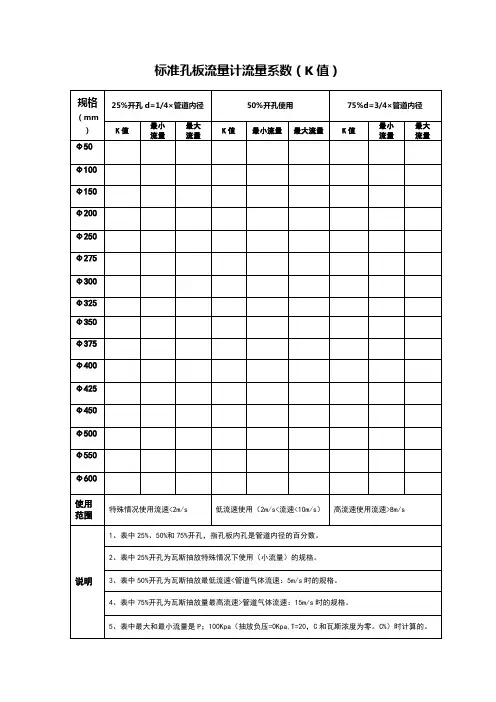
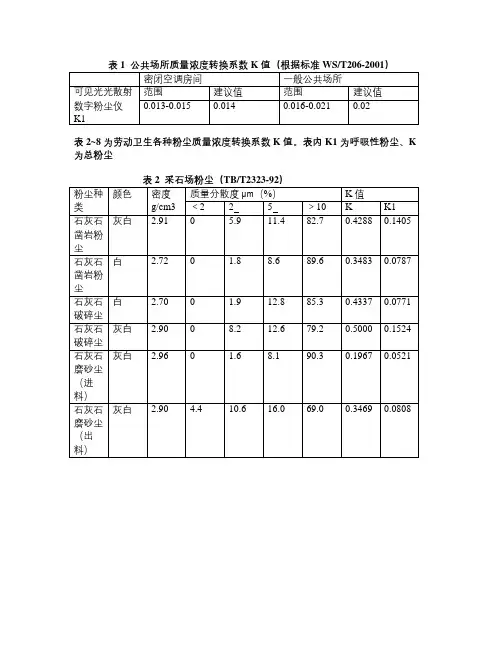
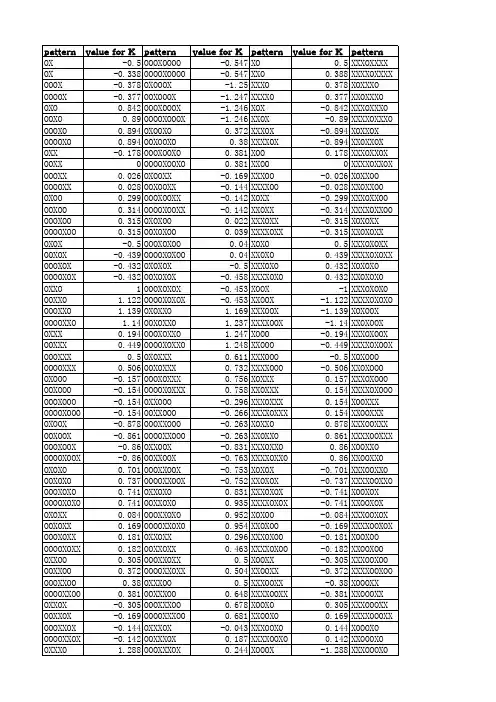
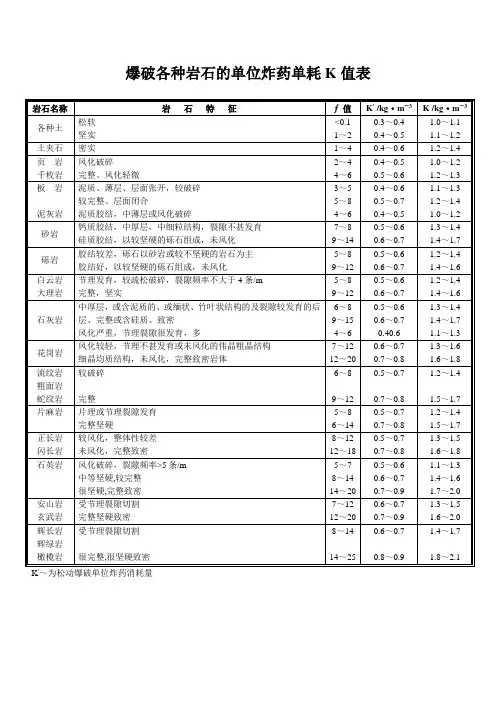
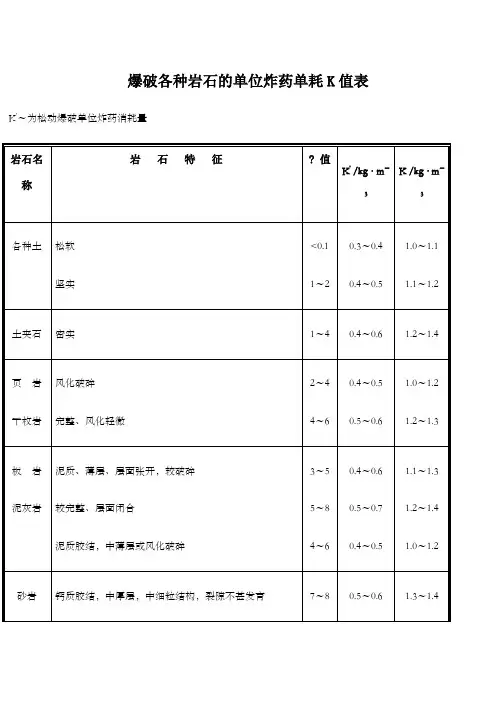
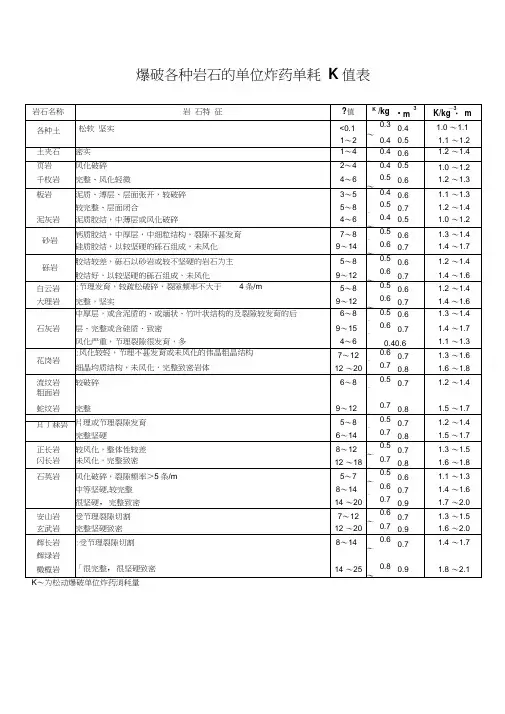
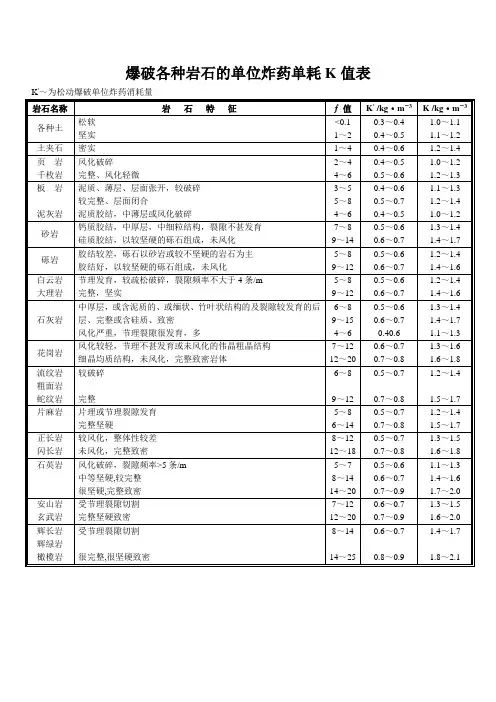
爆破各种岩石的单位炸药单耗K值表K'~为松动爆破单位炸药消耗量岩石名称岩石特征ƒ 值K' /kg·m-3 K /kg·m-3各种土松软坚实<0.11~20.3~0.40.4~0.51.0~1.11.1~1.2土夹石密实1~4 0.4~0.6 1.2~1.4页岩千枚岩风化破碎完整、风化轻微2~44~60.4~0.50.5~0.61.0~1.21.2~1.3板岩泥灰岩泥质、薄层、层面张开,较破碎较完整、层面闭合泥质胶结,中薄层或风化破碎3~55~84~60.4~0.60.5~0.70.4~0.51.1~1.31.2~1.41.0~1.2砂岩钙质胶结,中厚层,中细粒结构,裂隙不甚发育硅质胶结,以较坚硬的砾石组成,未风化7~89~140.5~0.60.6~0.71.3~1.41.4~1.7砾岩胶结较差,砾石以砂岩或较不坚硬的岩石为主胶结好,以较坚硬的砾石组成,未风化5~89~120.5~0.60.6~0.71.2~1.41.4~1.6白云岩大理岩节理发育,较疏松破碎,裂隙频率不大于4条/m完整,坚实5~89~120.5~0.60.6~0.71.2~1.41.4~1.6石灰岩中厚层,或含泥质的、或缅状、竹叶状结构的及裂隙较发育的后层、完整或含硅质、致密风化严重,节理裂隙很发育,多6~89~154~60.5~0.60.6~0.70.40.61.3~1.41.4~1.71.1~1.3花岗岩风化较轻,节理不甚发育或未风化的伟晶粗晶结构细晶均质结构,未风化,完整致密岩体7~1212~200.6~0.70.7~0.81.3~1.61.6~1.8流纹岩粗面岩蛇纹岩较破碎完整6~89~120.5~0.70.7~0.81.2~1.41.5~1.7片麻岩片理或节理裂隙发育完整坚硬5~86~140.5~0.70.7~0.81.2~1.41.5~1.7正长岩闪长岩较风化,整体性较差未风化,完整致密8~1212~180.5~0.70.7~0.81.3~1.51.6~1.8石英岩风化破碎,裂隙频率>5条/m中等坚硬,较完整很坚硬,完整致密5~78~1414~200.5~0.60.6~0.70.7~0.91.1~1.31.4~1.61.7~2.0安山岩玄武岩受节理裂隙切割完整坚硬致密7~1212~200.6~0.70.7~0.91.3~1.51.6~2.0辉长岩辉绿岩橄榄岩受节理裂隙切割很完整,很坚硬致密8~1414~250.6~0.70.8~0.91.4~1.71.8~2.1。
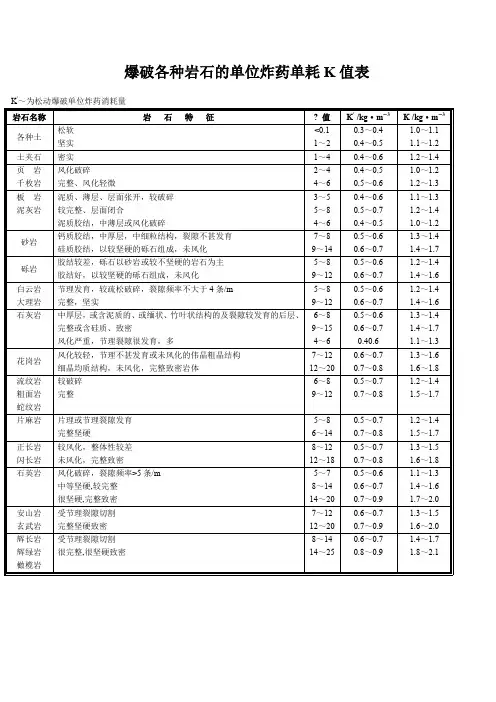
爆破各种岩石的单位炸药单耗K值表K'~为松动爆破单位炸药消耗量岩石名称岩石特征? 值K' /kg·m-3 K /kg·m-3各种土松软坚实<0.11~20.3~0.40.4~0.51.0~1.11.1~1.2土夹石密实1~4 0.4~0.6 1.2~1.4页岩千枚岩风化破碎完整、风化轻微2~44~60.4~0.50.5~0.61.0~1.21.2~1.3板岩泥灰岩泥质、薄层、层面张开,较破碎较完整、层面闭合泥质胶结,中薄层或风化破碎3~55~84~60.4~0.60.5~0.70.4~0.51.1~1.31.2~1.41.0~1.2砂岩钙质胶结,中厚层,中细粒结构,裂隙不甚发育硅质胶结,以较坚硬的砾石组成,未风化7~89~140.5~0.60.6~0.71.3~1.41.4~1.7砾岩胶结较差,砾石以砂岩或较不坚硬的岩石为主胶结好,以较坚硬的砾石组成,未风化5~89~120.5~0.60.6~0.71.2~1.41.4~1.6白云岩大理岩节理发育,较疏松破碎,裂隙频率不大于4条/m完整,坚实5~89~120.5~0.60.6~0.71.2~1.41.4~1.6石灰岩中厚层,或含泥质的、或缅状、竹叶状结构的及裂隙较发育的后层、完整或含硅质、致密风化严重,节理裂隙很发育,多6~89~154~60.5~0.60.6~0.70.40.61.3~1.41.4~1.71.1~1.3花岗岩风化较轻,节理不甚发育或未风化的伟晶粗晶结构细晶均质结构,未风化,完整致密岩体7~1212~200.6~0.70.7~0.81.3~1.61.6~1.8流纹岩粗面岩蛇纹岩较破碎完整6~89~120.5~0.70.7~0.81.2~1.41.5~1.7片麻岩片理或节理裂隙发育完整坚硬5~86~140.5~0.70.7~0.81.2~1.41.5~1.7正长岩闪长岩较风化,整体性较差未风化,完整致密8~1212~180.5~0.70.7~0.81.3~1.51.6~1.8石英岩风化破碎,裂隙频率>5条/m中等坚硬,较完整很坚硬,完整致密5~78~1414~200.5~0.60.6~0.70.7~0.91.1~1.31.4~1.61.7~2.0安山岩玄武岩受节理裂隙切割完整坚硬致密7~1212~200.6~0.70.7~0.91.3~1.51.6~2.0辉长岩辉绿岩橄榄岩受节理裂隙切割很完整,很坚硬致密8~1414~250.6~0.70.8~0.91.4~1.71.8~2.1。
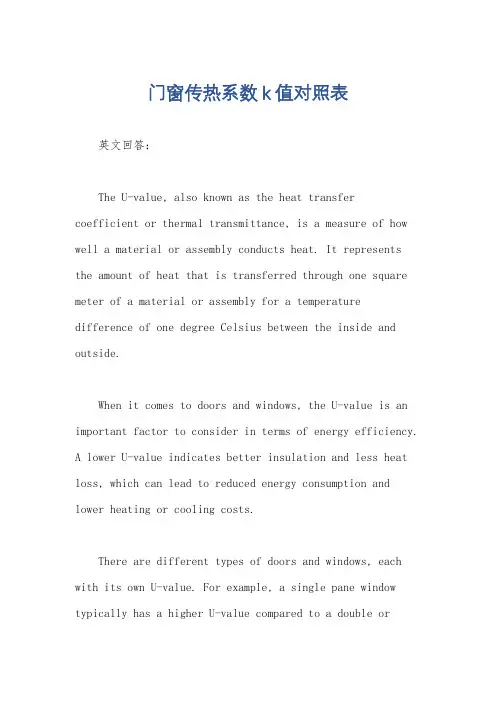
门窗传热系数k值对照表英文回答:The U-value, also known as the heat transfercoefficient or thermal transmittance, is a measure of how well a material or assembly conducts heat. It represents the amount of heat that is transferred through one square meter of a material or assembly for a temperaturedifference of one degree Celsius between the inside and outside.When it comes to doors and windows, the U-value is an important factor to consider in terms of energy efficiency.A lower U-value indicates better insulation and less heat loss, which can lead to reduced energy consumption and lower heating or cooling costs.There are different types of doors and windows, each with its own U-value. For example, a single pane window typically has a higher U-value compared to a double ortriple pane window. This is because multiple layers of glass with air or gas-filled spaces provide better insulation.Let's take an example to illustrate the importance of U-value in choosing doors and windows. Imagine you have a house with single pane windows that have a high U-value. During the winter, when the temperature outside is cold, the heat from inside your home will easily escape through the windows, resulting in a chilly interior and increased energy usage to maintain a comfortable temperature. On the other hand, if you have double or triple pane windows with a lower U-value, the heat loss will be significantly reduced, resulting in a warmer and more energy-efficient home.中文回答:传热系数K值,也称为热传导系数或热传递率,是衡量材料或组件导热性能的指标。